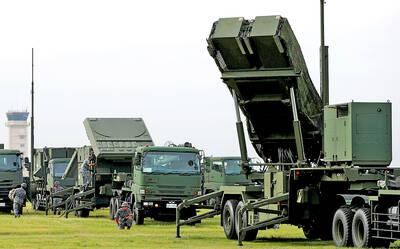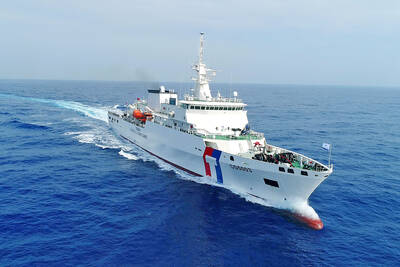The most ambitious bid yet to stop the worst oil spill in US history ended in failure on Saturday after BP was unable to overwhelm the gusher of crude with heavy fluids and junk.
US President Obama called the setback “as enraging as it is heartbreaking.”
The oil giant immediately began readying its next attempted fix, using robot submarines to cut the pipe that’s gushing the oil into the Gulf of Mexico and cap it with funnel-like device, but the only guaranteed solution remains more than two months away.
The company determined the “top kill” had failed after it spent three days pumping heavy drilling mud into the crippled well 1,520m underwater. It’s the latest in a series of failures to stop the crude that’s fouling marshland and beaches, as estimates of how much oil is leaking grow more dire.
The spill is the worst in US history — exceeding the 1989 Exxon Valdez disaster — and has dumped between 68 million liters and 150 million liters into the Gulf, according to government estimates.
“This scares everybody, the fact that we can’t make this well stop flowing, the fact that we haven’t succeeded so far,” BP PLC chief operating officer Doug Suttles said on Saturday. “Many of the things we’re trying have been done on the surface before, but have never been tried at 5,000 feet [1,524m].”
Frustration has grown as drifting oil closes beaches and washes up in sensitive marshland. The damage is underscored by images of pelicans and their eggs coated in oil. Below the surface, oyster beds and shrimp nurseries face certain death. Fishermen complain there’s no end in sight to the catastrophe that’s keeping their boats idle.
News that the top kill fell short drew a sharply worded response from Obama a day after he visited the Gulf Coast to see the damage firsthand.
“It is as enraging as it is heartbreaking, and we will not relent until this leak is contained, until the waters and shores are cleaned up, and until the people unjustly victimized by this manmade disaster are made whole,” Obama said on Saturday.
In the days after the spill, BP was unable to use robot submarines to close valves on the massive blowout preventer atop the damaged well, then two weeks later ice-like crystals clogged a 90 tonne box the company tried placing over the leak. Earlier this week, engineers removed a 1.6km-long siphon tube after it sucked up a disappointing 3.4 million liters of oil from the gusher.
In the latest try, BP engineers pumped more than 4.5 million liters of heavy drilling mud into the well and also shot in assorted junk, including metal pieces and rubber balls.

MILITARY BOOST: The procurement was planned after Washington recommended that Taiwan increase its stock of air defense missiles, a defense official said yesterday Taiwan is planning to order an additional four PAC-3 MSE systems and up to 500 missiles in response to an increasing number of missile sites on China’s east coast, a defense official said yesterday. The official, who spoke on condition of anonymity, said that the proposed order would be placed using the defense procurement special budget, adding that about NT$1 trillion (US$32,88 billion) has been allocated for the budget. The proposed acquisition would include launchers, missiles, and a lower tier air and missile defense radar system, they said The procurement was planned after the US military recommended that Taiwan increase

POLITICAL AGENDA: Beijing’s cross-strait Mid-Autumn Festival events are part of a ‘cultural united front’ aimed at promoting unification with Taiwan, academics said Local authorities in China have been inviting Taiwanese to participate in cross-strait Mid-Autumn Festival celebrations centered around ideals of “family and nation,” a move Taiwanese academics said politicizes the holiday to promote the idea of “one family” across the Taiwan Strait. Sources said that China’s Fujian Provincial Government is organizing about 20 cross-strait-themed events in cities including Quanzhou, Nanping, Sanming and Zhangzhou. In Zhangzhou, a festival scheduled for Wednesday is to showcase Minnan-language songs and budaixi (布袋戲) glove puppetry to highlight cultural similarities between Taiwan and the region. Elsewhere, Jiangsu Province is hosting more than 10 similar celebrations in Taizhou, Changzhou, Suzhou,

TWO HEAVYWEIGHTS: Trump and Xi respect each other, are in a unique position to do something great, and they want to do that together, the US envoy to China said The administration of US President Donald Trump has told Chinese President Xi Jinping (習近平) “we don’t want any coercion, but we want [the Taiwan dispute] resolved peacefully,” US ambassador to China David Perdue said in a TV interview on Thursday. Trump “has said very clearly, we are not changing the ‘one China’ policy, we are going to adhere to the Taiwan Relations Act, the three communiques and the ‘six assurances’ that were done under [former US president Ronald] Reagan,” Perdue told Joe Kernen, cohost of CNBC’s Squawk Box. The act, the Three Joint Communiques and the “six assurances” are guidelines for Washington

DEEPENING TIES: The two are boosting cooperation in response to China’s coercive actions and have signed MOUs on search-and-rescue and anti-smuggling efforts Taiwan and Japan are moving to normalize joint coast guard training and considering the inclusion of other allies, the Japanese Yomiuri Shimbun reported yesterday. Both nations’ coast guards in June sent vessels to the seas south of the Sakishima Islands to conduct joint training, the report said, adding that it was the second joint maritime training exercise since the nations severed formal diplomatic ties in September 1972. Japan dispatched the Nagoya Coast Guard’s Mizuho, a 134m, 6,000-tonne patrol vessel which can carry a helicopter, while the Coast Guard Administration (CGA) sent the 126m, 4,000-tonne Yunlin, one of its largest vessels, the report